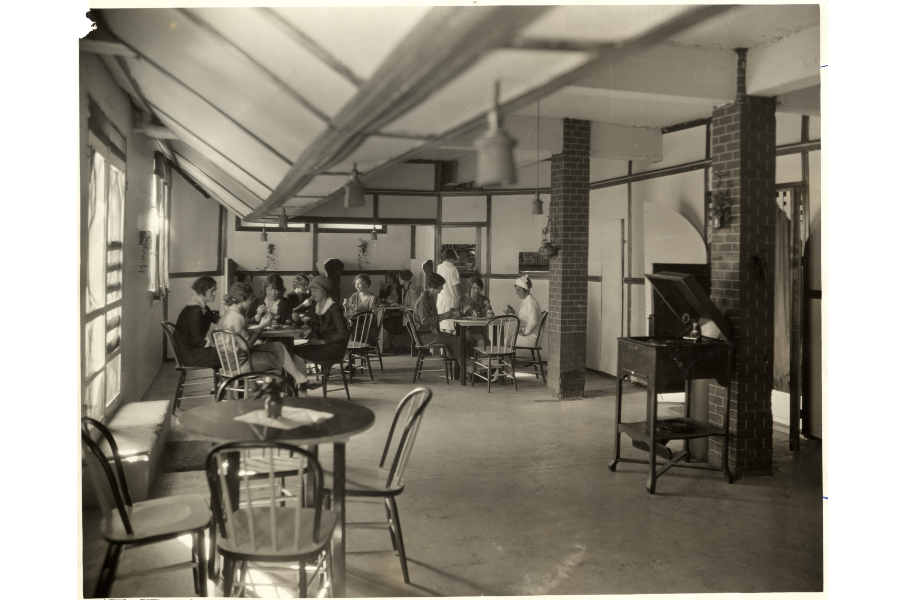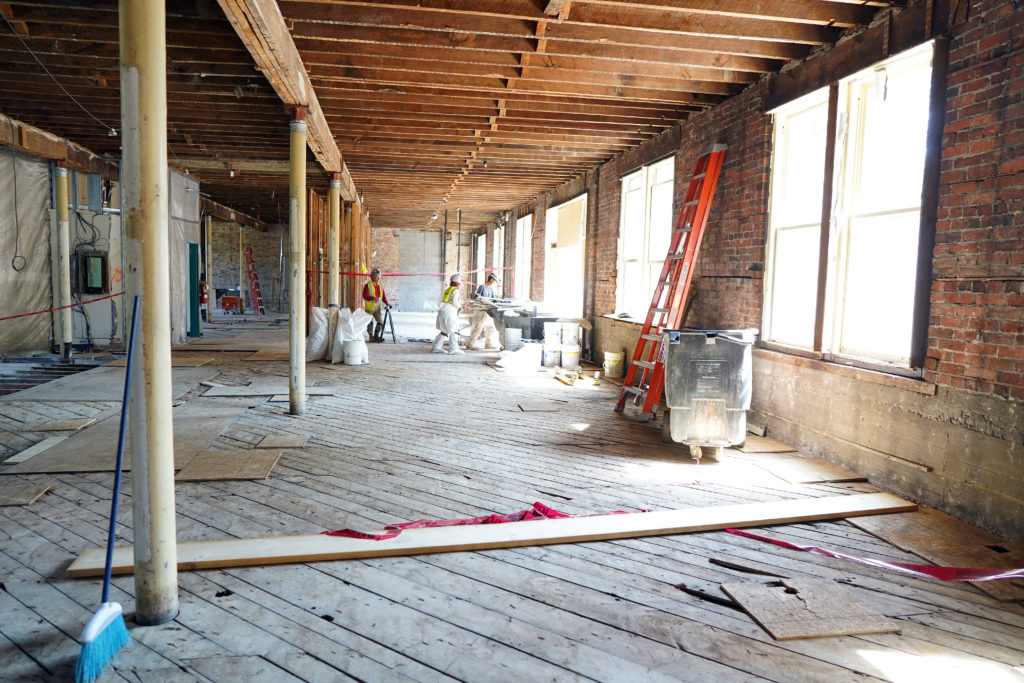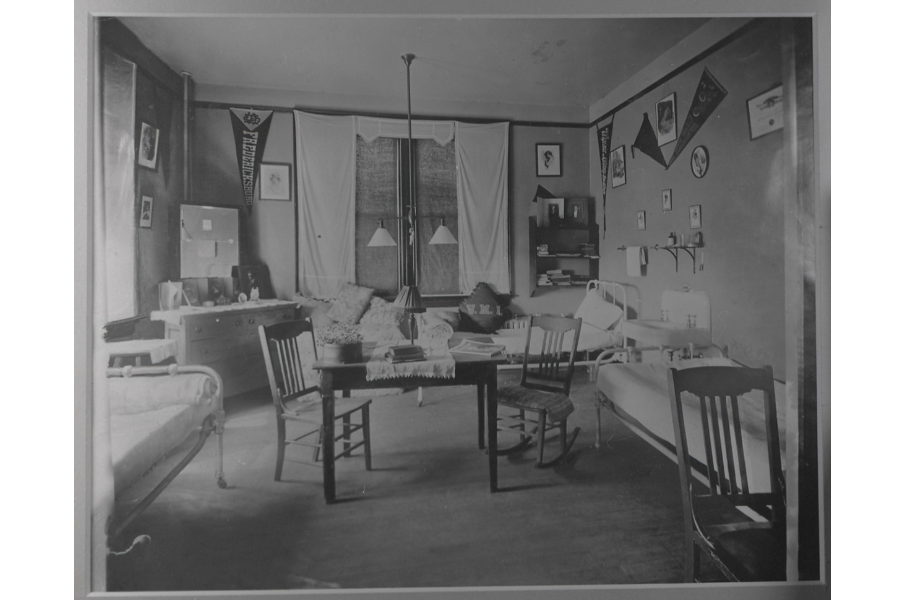Sam Biggers ’16 must have passed Willard Hall hundreds of times in his four years at the University of Mary Washington. He’d heard that the oldest residence hall on campus had a floor plan like a labyrinth.

But Biggers never saw it for himself. There was no reason to think he would. After earning a degree in historic preservation, he headed to Charleston for graduate school.
Sometimes, though, life is circular.
The building Biggers never set foot in as a student at UMW is now his full-time job. He’s a project engineer for Kjellstrom and Lee, the Richmond, Virginia-based construction management firm overseeing a $16.5 million renovation of Willard Hall.
Heralded in the University’s 1912-1913 catalog as “convenient, handsome and equipped with all modern conveniences,” the historic structure was taken out of commission a year ago when a steam line ruptured. Willard Hall went to the top of the list of buildings in line for an overhaul.

Willard opened to students in 1911 when Mary Washington was a normal school for women.
Sixty-five spacious bedrooms housed students three to a room. The building also served in its earliest days as a dining hall, laundry facility and heating plant, according to a building history.
The heating plant and laundry facility eventually moved out. The dining hall and kitchen were turned into rooms as enrollment soared. A shower room went in and then came out. Doorways were enclosed. In the late 1970s, workers added ramps, stairways and suite bathrooms that projected into once airy hallways. They put in kitchenettes and telephone booths. Closets and plaster walls came down and partitions went up.

Over the years, workers were careful not to alter the integrity of the aging building. But by the time Biggers arrived for his freshman year in 2012, the floor plan hardly resembled its former self, and students talked about how easy it was to get lost in Willard Hall.
It no longer housed three to a room. It was a singles hall, home to eighty-eight upperclassmen, until the steam line rupture in the summer of 2017 rendered it unlivable.
Biggers was midway through his graduate program in historic preservation at Clemson University at the time. He was also set to finish up just as Kjellstrom and Lee began work on Willard Hall. The firm has handled projects at universities across Virginia.

Biggers knew UMW. He’d been an intern with Facilities Services while an undergraduate. He had a working relationship with Gary Hobson, UMW’s director of capital planning and construction, and Bruce Blair, a project inspector, as well as others who would play key roles in the renovation.
Hobson was thrilled when he learned Biggers was returning to UMW. He’d first heard about Biggers in 2014, when Michael Spencer, chair of the Department of Historic Preservation, recommended him for an internship. Biggers quickly lived up to his reputation as a hard worker.
“He’s an invaluable member of this team,” Hobson said of the former student’s role as project engineer.
Biggers also loved old buildings. He’d grown up in Staunton, in a house built in 1836 and filled with antiques. In high school, he searched the home’s tax and title records.
“There wasn’t anything really interesting about it,” he said. “But it got the gears turning.”
So much that he came to Mary Washington to study historic preservation. And returned to Fredericksburg two years after he left to work on one of UMW’s most historic buildings.

As project engineer, Biggers is responsible for managing documents for the construction process, such as official correspondence, material specifications and daily work reports. He also works with the site superintendent overseeing ongoing work. This requires a thorough understanding of the building’s renovation plans, which he studies along with his colleagues to make sure the work is done accurately and on time.
It feels different this time around. Most of Biggers’ friends have moved away. There’s no more school work. He wears a hard hat and work boots when he walks into Willard, stripped all the way to the floor joists and cast-iron columns.
But there are friendly faces here. And UMW still holds the familiarity of home.

Biggers keeps on his computer photographs of Willard from its earliest days. Young ladies in dresses and hats sipping tea at small tables in the basement and taking meals in the vast dining hall. A student room furnished with a sink and three iron beds and a sunlit lounge filled with wicker chairs and loveseats.
Scheduled to reopen in August 2019, Willard will more closely resemble what the architects intended a century ago, Biggers said. Plans call for a large, open gathering space on the first floor, unobstructed hallways and double rooms housing about 170 students. Workers will preserve as much of the original maple flooring as possible.

“In terms of returning the building and the space to what it once was, it is a restoration,” he said.
There will be upgrades, too, including double-paned, energy-efficient windows, an elevator, new plumbing, new mechanical and electrical systems and a new, interlocking metal roof, Hobson said.
“It will be a shining example of what Mary Washington is all about,” Biggers said.
And he would know.
I was Sam’s R.A. his freshman year and I’m just so proud of his accomplishments over the years. He has always been a remarkable person. I personally lived in Willard as well, the summer of 2009 and even then it need some TLC. I’m very happy for Sam and I know he will be successful working on this project and in life and also I can’t wait to see Willard next year!
Hasn’t Mary Washington always been a normal school for women?
I spent my 18th birthday moving into a 2nd floor corner room with 2 other girls. Closets were minuscule, bathrooms were on the hall, and stairways were original and elegant (and had awesome acoustics). The other rooms were doubles, but corners were triples. First floor front housed the formal parlor and dorm mother’s apartment. Laundry machines, kitchen and snack machines were in the basement. Furniture was . . . serviceable. Curfews, no a/c, faulty doorknobs, study parlors on the first floor side entrances, great, airy windows, and an air of faded elegance made Willard special. And, it was close to Seacobeck, Monroe, Trinkle Library AND the C Shop!!
I lived in Willard my freshman year—1965. It was old but had open, airy spaces with wide hallways, large windows and generous size rooms for 3 girls. I was so distressed with the renovation that I never went in again after I saw it the first time. I am so happy that another renovation is occurring that is more sensitive to the original character of the building. I am counting on you, Sam.
Particularly enjoyed your article on the Willard restoration! My aunt, Nora Lena Matthews, was a resident there around 1916, but believe most of her photographs from that time are exterior shots. I lived in Willard also as a MWC Junior in 1967-68, — with a great group Freshmen from the Class of ’71!
I lived in Willard with two roommates my freshman year in the late 1950s and again my junior year with 1 roommate who was a Freshman Counselor.
I remember Willard was so noisy, so many people, the bathrooms down the hall, tiny room for 3 girls with 2 closets and not getting enough sleep. But after I got used to it, I couldn’t stand being alone or without the chatter, records playing, people yelling “phone call for (someone).” or “You have a guest in the parlor” which meant your date was waiting for you. It was a not pretty dorm but it was home for the school year and I loved it.
I wish you well, Sam because that dorm needed a restoration way back then.
Susan